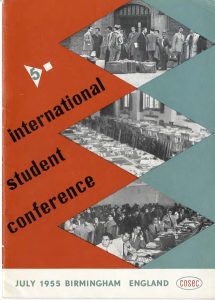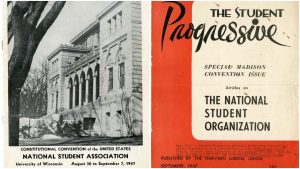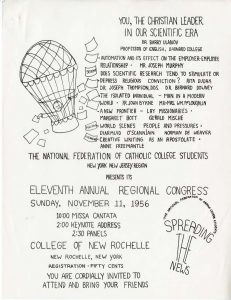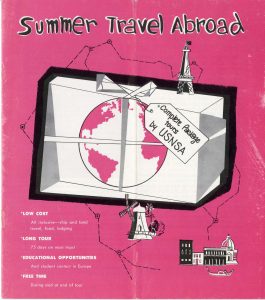
Today’s post is guest authored by Justin Gould, a MA student in Library and Information Science at Catholic University.
The collection of John P. O’Connor consists of materials collected by the eponymous man ranging from 1937 to 1967. These materials largely represent organizing efforts in student life during the mid-twentieth century, including reports, marketing materials, personal correspondence, and newspaper articles. The experience I had while processing this collection was educational, but also exciting and entertaining at times.
John Patrick O’Connor was born on December 27, 1931. He graduated from Manhattan College in 1956, and remained active in collecting information about the United States National Student Association (NSA) until 1967. From its inception in 1947, the NSA was a confederation of college and university student governments. In 1967, it would be revealed that much of the NSA’s operations had been secretly funded by the CIA, as a perceived counterweight to Soviet-backed international student groups. While this may have led to O’Connor’s disengagement with the organization, the NSA would disavow its relationship with the CIA and continue operations until 1978.

While exploring the collection, I tried to puzzle out the views and beliefs of Mr. O’Connor, but always found myself unsure. He collected lists, names, and notes of all kinds, meticulously documenting the student organizing scene from the rise of the NSA in the 1940s, formed as a bulwark and western alternative to the International Student Union – a Soviet organ – to various student groups and movements in the 1960s, far beyond his graduation from Manhattan College. He collected official communist newspapers, unaffiliated left-leaning flyers and journals, the works of noted racists and antisemites (in smaller portions), far-right propaganda from the 1950s, and standard, mainstream journalistic retinue. From his correspondence and personal collection the only conclusion I can make is that the man was passionate, bent on understanding and deconstructing the forces behind student groups and student organizing, possibly recognizing that the youth of tomorrow are the greatest force for change.

In the final periods of his collecting, he picked out newspapers from communist and left-leaning groups for their inclusion of articles exposing the influence of the national security apparatus in the student groups he worked in and around during the 1950s. These articles were published in the mid 1960s, and I can only assume the man had all but moved on from the day to day operations of the NSA and its affiliate groups by then. However, he was still fascinated by the mechanisms moving the world around him, and with this I can greatly sympathize.
I made the mistake early on of beginning with a physical inventory instead of a digital one, but that allowed me to make mistakes that would have been difficult to recover from on a digital scheme. When the collection was brought to me there was no original order to be truly found, so a full inventory and subsequent reordering was necessary. It was a task that, were I to do it again, I would start with a digital inventory. It took months, albeit part time, to finish cataloguing everything, and when I came out on the other end I understood vividly why archivists don’t typically do an item level inventory of a collection. Coming in at around 1,450 items, I wished that the collection had lent itself to a more concise way of processing. The completed collection, spanning four boxes, consists of hundreds of individual documents.

The finding aid is available online.
